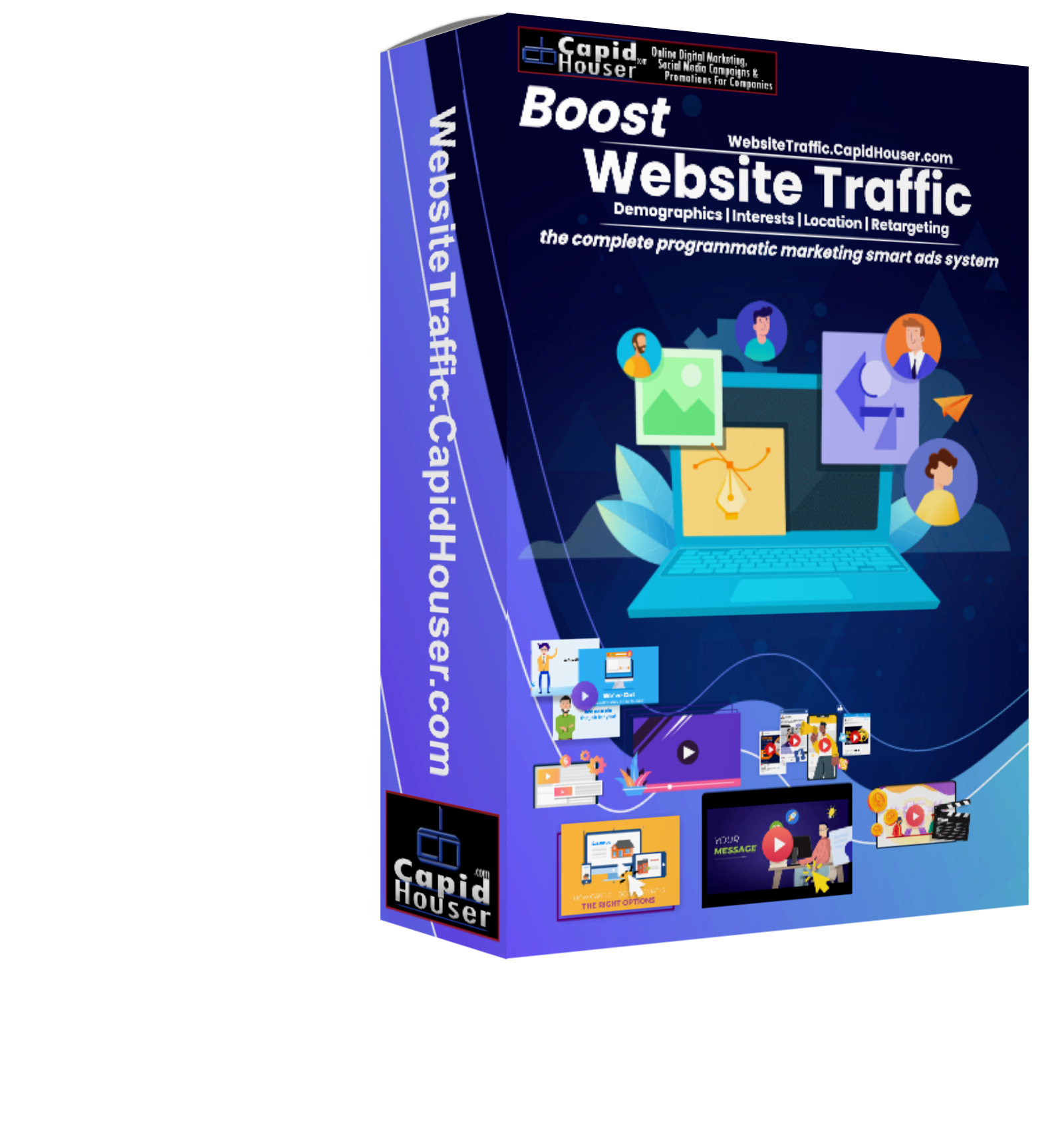Did you know that over 70% of businesses report paid traffic sources outperform organic marketing in the launch period of new campaigns ? With display ad spend in the UK projected to soar above £30 billion by 2025 , leveraging paid website traffic with display ads isn’t just a trend—it’s the cornerstone of scalable digital marketing success. In today’s fiercely competitive online landscape, mastering display ad strategies puts you ahead of the pack by driving targeted, measurable, and high-converting site traffic right when you need it most.
Paid Website Traffic with Display Ads: Surprising Growth Potential for Online Businesses
For modern organisations, paid website traffic with display ads offers an immediate avenue to capture new audiences, accelerate brand awareness, and swiftly achieve measurable digital growth. Unlike organic traffic, which accumulates gradually through search engine optimisation and content marketing, paid display advertising unleashes a controllable surge of web traffic. Businesses can target segments by demographics, behaviour, and intent—which makes this traffic source highly adaptable for both short-term promotions and long-term campaigns.
These display ads—graphical banners, videos, and dynamic formats—appear across a vast network of publisher sites via platforms like the Google Display Network and Facebook Ads. The ability to retarget visitors who have previously shown interest in your site further intensifies the power and ROI of display advertising. As digital marketing evolves, forward-thinking brands are making data-driven investments in display ads to remain agile, competitive, and top-of-mind for potential customers.
A Startling Statistic: How Display Ads Drive Paid Website Traffic Exponentially
Over 70% of businesses confirming paid traffic sources outperform organic in initial campaign periods.
Display ad spend is projected to surpass £30 billion in the UK by 2025.
Understanding Paid Website Traffic with Display Ads and Its Impact on Site Traffic and Conversions
Key Concepts: Paid Traffic, Organic Traffic, and the Role of Display Network

To unlock the full potential of digital marketing, it’s crucial to grasp the interplay between paid traffic , organic traffic , and the display network . Paid website traffic with display ads is generated by investing budget into visually engaging advertisements distributed across the internet’s vast display networks. This stands apart from organic traffic, which relies on the steady results of SEO, content, and unpaid site referrals. While organic traffic builds trust and authority over time, paid ads offer a fast track to prominent online visibility.
The display network serves as the distribution system for these paid traffic sources—think Google Display Network or Facebook Audience Network. Within these environments, your display ads are shown to targeted audiences based on defined interests, location, browsing behaviour, or intent. This powerful combination of reach and precision means you’re not just broadcasting to the web, but smartly placing your message in front of the right eyes at the right time. Paid advertising works in tandem with organic strategies to accelerate initial traction while supporting long-term brand initiatives.
-
You’ll learn:
What defines paid website traffic with display ads
How paid advertising complements organic traffic sources
The mechanics behind display ad placements on the display network
Comparing Traffic Sources for Website Growth | |||
Traffic Source |
Cost Method |
Best Use Case |
Potential ROI |
|---|---|---|---|
Paid Traffic |
CPC/CPM |
Immediate site traffic |
High (with optimised targeting) |
Organic Traffic |
Free (SEO) |
Long-term brand visibility |
Moderate to High |
Paid Traffic Sources |
Display Ads |
Brand awareness & retargeting |
High |
Choosing the Right Paid Traffic Source: Display Ads vs. Organic Traffic Channels

Comparing Paid Traffic, Paid Ad, and Organic Traffic for Website Traffic Goals
Selecting the ideal traffic source for your website hinges on a careful assessment of goals, budget, and timeline. Display ads shine as a paid traffic source for brands needing instant online presence, lead generation, or strategic retargeting. Their visual impact and granular targeting options make them particularly powerful for building brand awareness , nurturing potential customers through the buying journey, and reclaiming lost leads through remarketing.
In contrast, organic traffic remains the backbone of sustained web traffic—notably for businesses that have invested in content-rich platforms, technical SEO, and strong backlink profiles. Organic channels often have lower cost-per-acquisition over time, but growth is slower and less controllable. The true winning formula for most online businesses is a hybrid approach—a blend of paid traffic and organic channels—to multiply site traffic and conversion impact over the long term.
-
Detailed insights:
Strengths of display ads as a paid traffic source
When organic traffic is preferable
How a hybrid paid and organic approach can multiply results
“The future of digital marketing lies in leveraging multiple quality traffic sources—especially display ads—for measurable business growth.”
Display Ads Fundamentals: Types, Placements, and Display Networks for Paid Website Traffic
Understanding Display Network, Google Display, and Native Ads as Paid Traffic Sources
-
Explore:
How Google Display Network can unlock targeted paid website traffic
Differences between display ads, native ads, and banner ads
Integrating display ad strategies with paid advertising

The world of display advertising is richly diverse, spanning multiple ad types and placements. Google Display Network (GDN) enables your brand to appear on millions of websites, apps, and YouTube videos—reaching audiences well beyond search engine queries. Display ads can be static banners, dynamic rich media, interactive video, or even seamlessly integrated native ads designed to match the look and feel of third-party content.
Native advertising represents an evolved version of display ads, blending sponsored content into a user’s reading or viewing environment for less disruptive engagement. Both classic display ads and native ads can be used at different customer journey stages: awareness, consideration, and conversion. The flexibility to adjust placements, ad formats, and messaging ensures your marketing strategy aligns with where your potential customers are spending their time online.
By layering display network campaigns with robust targeting—demographics, intent, remarketing you can use paid traffic sources to drive traffic to your website efficiently. Modern marketers stitch together Google Display, native advertising, and even social channels to orchestrate unified, high-impact campaigns that consistently build business results.
Advanced Display Advertising Strategies to Boost Paid Website Traffic
Maximising Site Traffic with Retargeting, Remarketing, and Facebook Ad Campaigns
Utilising retargeting on display networks for repeat traffic
Using Facebook Ads in combination with display ads for paid traffic synergy
Layering Google Display targeting (affinity, intent, remarketing)

As the digital ad space matures, harnessing the synergy between different paid traffic sources can transform campaign outcomes. Retargeting through the display network means serving ads to prospects who have already interacted with your site, dramatically increasing conversion rates by staying top-of-mind. Remarketing extends this further by segmenting user lists and serving tailored messages, nudging potential customers through the next step in the buying cycle.
Pairing Facebook Ads with your display ad campaigns opens additional layers of custom audience targeting on one of the world’s largest social media platforms. By synchronising creative messaging across Google Display, Facebook, and other networks, brands magnify their reach and boost web traffic with unified, memorable experiences. Smart marketers use audience insights—such as interests, behaviour, and previous engagement—to layer target parameters for maximum impact.
To drive optimal results with advanced display advertising, consider multi-network experimentation, implement robust attribution modelling, and split-test campaign variables. The most successful campaigns are fueled by data, not guesswork, continually evolving as analytics reveal which traffic source or ad creative yields the highest ROI.
Essential Metrics: Measuring the Impact of Paid Website Traffic with Display Ads
KPIs: Site Traffic, Bounce Rate, Conversion Rate, and Paid Ad ROI
-
Core measurements:
Increase in website traffic and site engagement
ROI of paid ad spend
Cost per acquisition (CPA), cost per click (CPC), impression share

Knowing which metrics to track is essential for optimising your paid website traffic with display ads campaigns. Key performance indicators (KPIs) such as site traffic growth, bounce rate reduction, and conversion rate increases reveal how well your ads are driving targeted user behaviour. Effective campaigns monitor each traffic source to determine where your marketing budget is best invested.
Other crucial metrics include cost per acquisition (CPA) , cost per click (CPC) , and impression share. These provide insights into the efficiency and reach of your paid advertising efforts. Real-time analytics dashboards—integrated with Google Ads, Google Analytics, and social media ad platforms—allow marketers to attribute conversions accurately to specific display ads or networks, ensuring continuous campaign optimisation.
Ultimately, a data-driven approach to paid ad analytics empowers you to pinpoint the creative elements, placements, and networks that consistently deliver high-quality, conversion-ready website traffic. This iterative optimisation is the backbone of scalable digital marketing.
Optimising Paid Website Traffic Sources: Targeting and Creative Best Practices
Audience Segmentation and Ad Creative Tips for High-Performing Display Ads
Identifying high-value traffic sources through audience insights
Crafting compelling display ads tailored for segmented audiences
Continuous split-testing and creative refresh cycles

The key to maximising results from paid website traffic sources is a blend of razor-sharp audience targeting and resonant creative. Start by leveraging audience insights—such as demographics, behaviours, interests, and site engagement—to segment and prioritise high-value user groups. Targeting options in tools like Google Display Network and Facebook Ads Manager allow for granular control, ensuring your marketing messages reach the most likely converters.
Craft display ads that are visually striking, benefit-focused, and tailored to each audience segment’s expectations or pain points. This includes A/B testing headlines, images, calls to action, and even colour palettes. The creative process should always be cyclical—refreshing ad content regularly and analysing performance to refine what works best.
Continuous split-testing and a data-driven creative refresh cycle keep your campaigns from stagnating, preventing ad fatigue, and ensuring constantly improving ROI. Combining precision targeting with creative experimentation is what differentiates truly high-performing paid advertising campaigns in a crowded digital marketing landscape.
Case Studies: How Leading Brands Drove Massive Paid Website Traffic with Display Ads
Success Stories: Paid Advertising on Google Display Network, Facebook Ads, and Native Advertising
B2B SaaS company doubled site traffic within three months using targeted display ad campaigns
Retail brand achieved 5x ROI through layered paid traffic sources

Leading brands consistently demonstrate the transformative impact of well-executed display ad campaigns. For example, a B2B SaaS provider harnessed Google Display Network’s robust targeting to double their web traffic in just three months. By optimising their ad creative and remarketing tactics, they maintained cost efficiency while capturing valuable potential customers from a competitive landscape.
In another campaign, a retail brand combined Google Display, native advertising , and Facebook Ads to build potent, multi-touchpoint user journeys. Their layered approach increased brand awareness, supported retargeting, and ultimately delivered a remarkable 5x return on ad spend. These case studies underscore the power of strategic planning, continuous optimisation, and creative agility when driving site traffic with paid advertising.
The lessons learned: invest in data analytics, never stop split-testing, and always adjust your paid traffic sources to capitalise on new patterns in site engagement and conversion.
People Also Ask: What is the Best Paid Traffic for a Website?
Answer: The best paid traffic for a website often depends on business objectives, target audience, and budget. Display ads on large networks such as Google Display Network and Facebook Ads offer scalable paid website traffic. For direct sales, paid search and retargeting perform well. A mix of multiple high-quality paid traffic sources generally yields the highest returns.
People Also Ask: Can You Pay for Website Traffic?
Answer: Yes, businesses can pay for website traffic utilising paid traffic sources such as display ads, native advertising, paid search, and social media ads. By leveraging targeted paid ads on trusted networks, businesses drive relevant site traffic efficiently and can track precisely where their visitors originate.
People Also Ask: What Is the Difference Between Paid Search and Display Ads?
Answer: Paid search refers to ads shown on search engine results (such as Google Ads), triggered by specific keywords. Display ads, on the other hand, are graphical or video ads shown across websites within a display network. Paid search targets users with purchase intent, while display ads are highly effective for brand visibility and retargeting strategies.
People Also Ask: How Much Traffic Does a Website Need to Make Money from Ads?
Answer: While thresholds vary, most experts recommend a website achieves at least 10,000–20,000 monthly site visitors to realistically generate significant ad revenue through display ads, especially with high-value traffic sources and quality content.
Expert Tips and Actionable Takeaways for Amplifying Paid Website Traffic with Display Ads
-
Quick wins:
Test multiple display ad creatives and formats
Allocate budget across several paid traffic sources for resilience
Prioritise remarketing to improve conversion rates
Incorporate analytics to fine-tune campaigns continuously
Frequently Asked Questions About Paid Website Traffic with Display Ads and Traffic Sources
How does paid website traffic with display ads compare to SEO in the long term?
What budgets suit businesses just starting with paid advertising?
Are there risks with relying solely on paid ad campaigns for website traffic?
Get Expert Support to Accelerate Paid Website Traffic Growth with Display Ads
Contact us at https://www.capidhouser.com/paid-website-traffic/ to discuss your Retargeting & Remarketing strategy
Take action by diversifying your paid traffic sources, optimising your display ad strategies, and measuring results for continual improvement. Success in digital marketing starts with data-driven, creative display advertising.
To enhance your understanding of leveraging display ads for boosting paid website traffic, consider exploring the following resources:
“Display Advertising Traffic – Similarweb Knowledge Center” : This article provides a comprehensive overview of display advertising traffic, explaining how display ads function and their impact on website traffic. It also offers insights into analyzing display traffic to inform your advertising strategies. ( support.similarweb.com )
“The Best Paid Traffic Sources to Level Up Your Website | Taboola” : This resource outlines various paid traffic sources, including display advertising networks like Taboola, and discusses their effectiveness in driving website traffic. It includes case studies demonstrating successful campaigns and offers guidance on selecting the right platforms for your business. ( taboola.com )
By delving into these articles, you’ll gain valuable insights into optimizing display ad strategies to effectively increase your website’s paid traffic.
 Add Row
Add Row  Add
Add 




Write A Comment